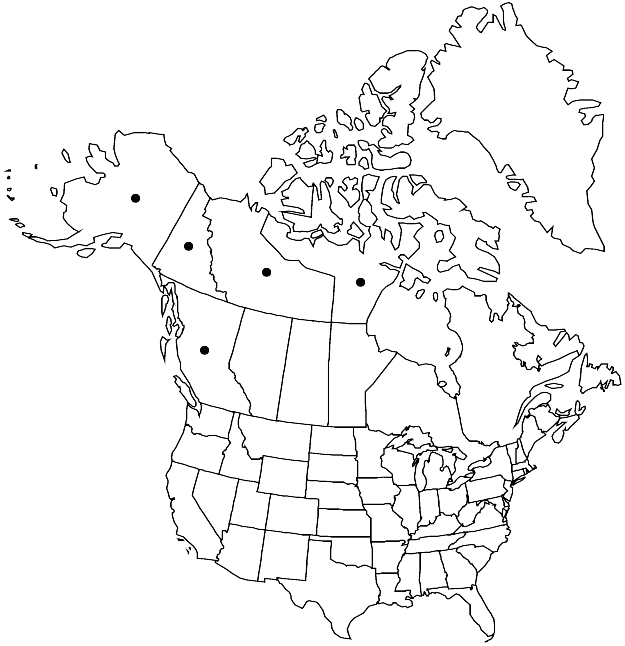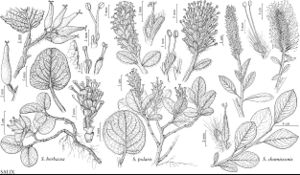Salix polaris
Fl. Lapp., 261, plate 13, fig. 1. 1812.
Plants 0.01–0.09 m, (dwarf), forming clones by rhizomes. Stems erect; branches redbrown, (often glaucous, dull), glabrous; branchlets brownish, glabrous. Leaves: stipules absent or rudimentary; petiole (deeply grooved), 1.3–10 mm, (glabrous adaxially); largest medial blade (deciduous in autumn, 2 pairs of secondary-veins arising at or close to base, arcing toward apex), elliptic, broadly elliptic, obovate, or subcircular, 5–32 × 7–18 mm, 1.1–2.8 times as long as wide, base convex, rounded, or cuneate, margins slightly revolute or flat, entire, ciliate, apex usually rounded or convex, sometimes retuse, abaxial surface (rarely glaucous), glabrous or pilose, adaxial slightly glossy, glabrous; proximal blade margins entire; juvenile blade glabrous. Catkins sometimes from subterminal buds; staminate 9–34 × 6–12 mm, flowering branchlet 1.5–14 mm; pistillate densely or moderately flowered (more than 15 flowers), stout to globose, 10–50 × 7–13 mm, flowering branchlet 1–12 mm; floral bract brown, black, or bicolor, 1.5–2.5 mm, apex rounded or convex, entire, abaxially sparsely hairy, hairs straight or wavy, (exceeding bract by 0.6–1.12–1.8 mm). Staminate flowers: abaxial nectary 0.3–0.7 mm, adaxial nectary oblong, narrowly oblong, square, or ovate, 0.5–1.4 mm, nectaries distinct; filaments usually distinct, sometimes connate proximally, glabrous; anthers ellipsoid or ovoid, 0.4–0.6 mm. Pistillate flowers: abaxial nectaries absent, adaxial nectary narrowly oblong, oblong, or ovate, 0.8–1.8 mm, longer than stipe; stipe 0.2–0.7 mm; ovary obclavate or pyriform, densely villous to pilose, hairs flattened, beak gradually tapering to or slightly bulged below styles; ovules 12–17 per ovary; styles connate to distinct 1/2 their lengths, 0.7–1.2 mm; stigmas flat, abaxially non-papillate with pointed tip, or slenderly to broadly cylindrical, 0.3–0.6 (–0.7) mm. Capsules 4.8–8.25 mm. 2n = 76, 114.
Phenology: Flowering mid Jun-early Aug.
Habitat: Arctic-alpine, moist late snowbed and snowflush areas, talus and scree slopes, sides of depressed center frost polygons, sedge meadows, and mud boils, calcareous tills, sandy marine silts
Elevation: 0-1800 m
Distribution

B.C., N.W.T., Nunavut, Yukon, Alaska, Eurasia (Chukotka), Eurasia (Novaya Zemlya), Eurasia (Russian Far East), Eurasia (arctic Siberia), Eurasia (Spitzbergen), Eurasia (and Sweden)
Discussion
The sectional placement of Salix polaris is uncertain. It was placed in sect. Myrtosalix (G. W. Argus 1997) but more recently Argus et al. (1999) placed it in sect. Herbella. This polyploid species may be an intersectional hybrid.
Hybrids:
Salix polaris forms natural hybrids with S. arctica and perhaps S. rotundifolia.
Salix polaris × S. rotundifolia: This putative hybrid occurs in Alaska and the Yukon. Many plants previously identified as S. rotundifolia but that have ovaries with hairs on the beaks or in patches, leaves not commonly marcescent, and catkins with fewer flowers than in S. polaris may be this hybrid.
Selected References
None.
